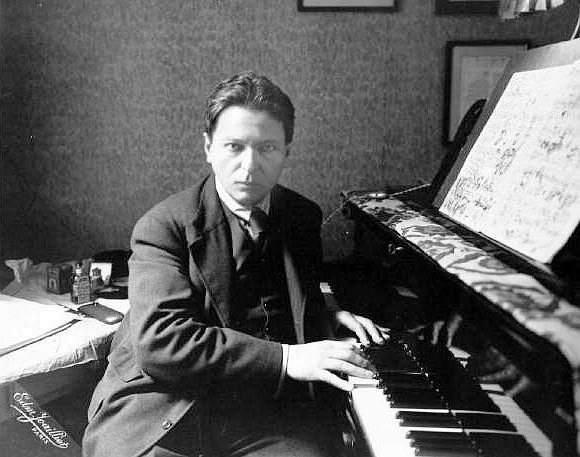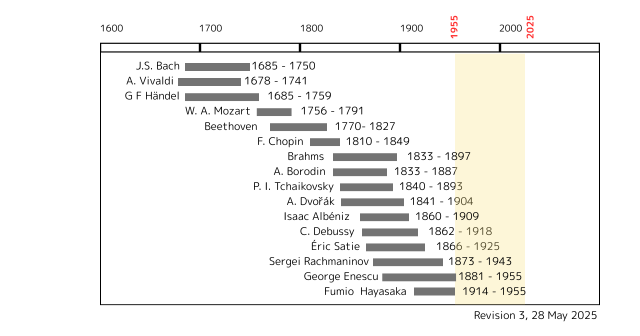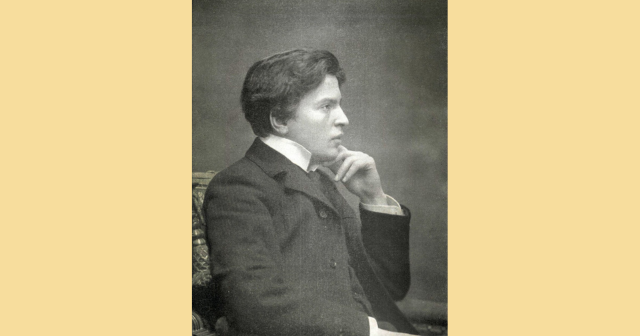All photos taken for this post were copied from Wikipedia (English and Romanian versions) with descriptions to declare public domain. Portrait of eye catch image is a work of Revista Luceafarul in year 1912.
The two Romanian Rhapsodies, Op. 11, for orchestra, are George Enescu’s best-known compositions. They were written in 1901, and first performed together in 1903. The two rhapsodies, and particularly the first, have long held a permanent place in the repertory of every major orchestra. They employ elements of lăutărească music, vivid Romanian rhythms, and an air of spontaneity. They exhibit exotic modal coloring, with some scales having ‘mobile’ thirds, sixths or sevenths, creating a shifting major/minor atmosphere, one of the characteristics of Romanian music.
ジョルジェ・エネスクによる《ルーマニア狂詩曲》作品11の第1番と第2番は、エネスクの作品の中で最もよく知られている楽曲。1901年に作曲され、1903年に初めて演奏されました。2つの狂詩曲、特に第1番は、長年にわたり主要なオーケストラの常設レパートリーとして定着している。
2つの作品には、ルーマニアのラウタレアスカ音楽の要素、生き生きとしたルーマニアのリズム、そして即興性のある雰囲気が取り入れられています。また、旋法的な色彩も異国情緒を帯びており、一部の音階では第3音、第6音、第7音が「可変」的に扱われ、長調と短調が移ろう雰囲気を醸し出している。ルーマニア音楽の特徴の一つである。
Only a small portion is introduced here, but I highly recommend listening to the entire First Rhapsody. It is a colorful and adventurous composition that encapsulates every possible way an orchestra can be made to sound. For those of us engaged in DTM (desktop music production), it serves as a valuable subject for study.
ここではごく一部のみ紹介しているが、第1番を通しで聴いていただきたい。オーケストラの「鳴らし方」の全てをひとまとめにした多彩で冒険的な作曲である。DTMに取り組む我々にとっては貴重な研究対象だ。
George Enescu (19 August [O.S. 7 August] 1881 – 4 May 1955), known in France as Georges Enesco, was a Romanian composer, violinist, pianist, conductor, and teacher and is regarded as one of the greatest musicians in Romanian history.
Pablo Casals described Enescu as “the greatest musical phenomenon since Mozart” and “one of the greatest geniuses of modern music”. Queen Marie of Romania wrote in her memoirs that “in George Enescu was real gold”. Yehudi Menuhin, Enescu’s most famous pupil, once said about his teacher: “He will remain for me the absoluteness through which I judge others”, and “Enescu gave me the light that has guided my entire existence.” He also considered Enescu “the most extraordinary human being, the greatest musician and the most formative influence” he had ever experienced. Vincent d’Indy claimed that if Beethoven’s works were destroyed, they could be all reconstructed from memory by George Enescu. Alfred Cortot, one of the greatest pianists of all time, once said that Enescu, though primarily a violinist, had better piano technique than his own.
ジョルジェ・エネスク(1881年8月19日[ユリウス暦では8月7日]– 1955年5月4日)は、フランスでジョルジュ・エネスコとして知られるルーマニアの作曲家、ヴァイオリニスト、ピアニスト、指揮者、そして教師で、ルーマニア音楽史上もっとも偉大な音楽家のひとりとされている。
パブロ・カザルスはエネスクを「モーツァルト以来最大の音楽的現象」そして「現代音楽最大の天才のひとり」と評した。ルーマニアのマリー王妃は回想録の中で「ジョルジェ・エネスクの中には本物の金の価値があった」と書いている。エネスクの最も有名な弟子であるイェフディ・メニューインは、「他者を判断する際の絶対的基準として、私の中に存在し続けている」と語り、「エネスクは、私の人生全体を導く光を与えてくれた」とも言っている。
作曲家ヴァンサン・ダンディは、「もしベートーヴェンの作品がすべて失われたとしても、エネスクなら記憶だけで全てを再現できるだろう」としている。ピアノ界の巨匠アルフレッド・コルトーも、エネスクは本来ヴァイオリニストでありながら、自分よりも優れたピアノ技術を持っていたと語っている。

Copy right of George Enescu has expired on May 2025, some 70 years since his death.


コメント